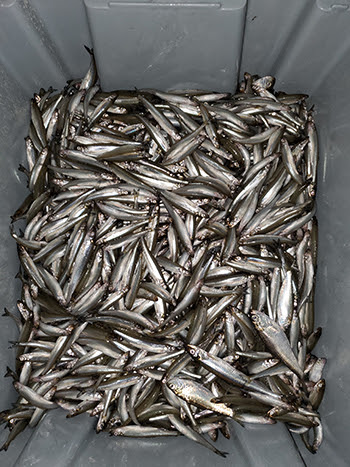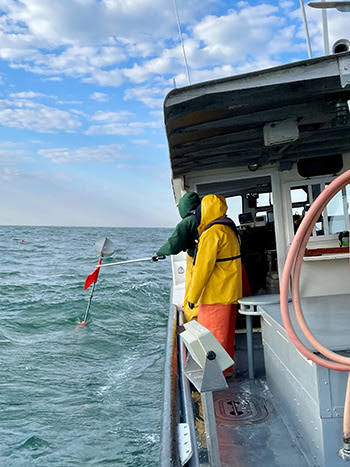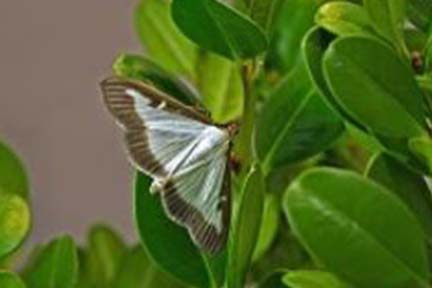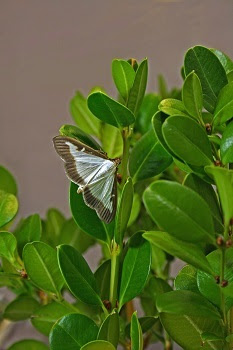| Nov. 9, 2022
Contacts: Gary Whelan, 517-242-2767
Lake Michigan: Ben Turschak, 231-350-9440 and Dave Clapp, 231-330-6745
Saginaw Bay: David Fielder, 989-590-8956, Andrew Briggs, 586-612-9228 and Todd Wills 586-904-2058
Lake Erie: Sara Thomas, 734-718-0474 and Todd Wills 586-904-2058
DNR shares fisheries survey findings from Lake Michigan, Lake Erie and Saginaw Bay
A lot of factors go into effective fisheries management, including the valuable research data conducted each year by Michigan Department of Natural Resources research vessels on Lake Michigan, Lake Erie and Saginaw Bay that guides management decisions on how best to care for fisheries now and for future generations.
DNR Fisheries Chief Jim Dexter said the most recent survey results highlight important population trends among walleye, yellow perch and other species, as well as factors such as angler intensity and presence of forage fish.
“Regular surveying of Michigan waters tells us things about state fisheries that we’re not going to learn through other means, and that data helps us make sound, informed choices for different regions,” said DNR Fisheries Chief Jim Dexter. “Our research crews and biologists, along with state and federal partners, do an incredible job of collecting and analyzing information that’s essential to these three regions.”
Here are the highlights by each survey area:
 The DNR’s survey vessel Steelhead and vessels from two other agencies cooperatively plied the waters of Lake Michigan in August, sampling key forage fish populations critical to the health of salmon, steelhead and lake trout, and found forage fish numbers to be improving in Michigan waters. The DNR’s survey vessel Steelhead and vessels from two other agencies cooperatively plied the waters of Lake Michigan in August, sampling key forage fish populations critical to the health of salmon, steelhead and lake trout, and found forage fish numbers to be improving in Michigan waters.
The 2022 hydroacoustic survey comprised 26 transects spanning nearshore and offshore regions around Lake Michigan. A transect essentially is a predetermined line, from point A to point B, that determines the survey route.
The S/V Steelhead completed 13 of these transects in cooperation with the U.S. Geological Survey research vessel Sturgeon (eight transects) and the U.S. Fish and Wildlife Service R/V Baird (five transects).
“The work was completed in late summer in spite of midseason shipyard repair delays that gave the S/V Steelhead a later-than-normal start,” said Dave Clapp, Charlevoix Fisheries Research Station manager. “Thanks to the crew’s hard work and favorable weather, though, the S/V Steelhead was able to complete the largest number of annual survey transects since this survey began in 2004.” |
 Transects completed by the S/V Steelhead this season stretched from waters offshore of Chicago in the south, around the Michigan shore, to Platte Bay in the north. At roughly the same time, the R/V Sturgeon completed transects along the Illinois and Wisconsin shore in the west, while the R/V Baird completed transects along the Wisconsin and Michigan shore in the north. Transects completed by the S/V Steelhead this season stretched from waters offshore of Chicago in the south, around the Michigan shore, to Platte Bay in the north. At roughly the same time, the R/V Sturgeon completed transects along the Illinois and Wisconsin shore in the west, while the R/V Baird completed transects along the Wisconsin and Michigan shore in the north.
While final survey results have not yet been compiled, several noteworthy observations emerged:
- As expected in recent years, forage fish abundance was much greater in nearshore areas than further offshore. However, unlike previous years, midwater trawl catches and apparent fish densities were higher in the northeast nearshore than in the southeast nearshore where fish abundance is nearly always greatest.
- Largest catches in midwater trawls were yearling and older rainbow smelt, alewife and bloater. Yearling and older rainbow smelt have rarely been encountered in recent years, so the large catches this year mark a sharp departure from recent surveys.
- The size distribution of the alewives captured in 2022 was also very different than recent years. Typically, smaller size groups have dominated the catch, but this year’s alewife catches included a much broader range of sizes from 4-8 inches and included some large individuals greater than 8 inches in length. Moreover, very few young-of-year (< 4 inches) alewives were captured at any transect location. These results may indicate that 2022 was a low recruitment year for alewives, but also that predation and other mortality was low, allowing some to survive to larger sizes.
- Finally, acoustic density estimates and midwater trawl catches of bloater have been increasing in recent years; 2022 survey results suggest that densities of bloater continue to remain high and may be increasing regionally in Lake Michigan.
Overall, the forage community is showing signs of improvement that bodes well for future fishing on Lake Michigan. |
 Based on the 24 trawl tows and 16 gillnet lifts conducted in September by the Department’s R/V Tanner and Channel Cat, initial findings indicate few changes to the Saginaw Bay fishery. Overall, a total of 24 different species were collected by trawling and 27 different species were collected by gillnetting, with no new species collected. Based on the 24 trawl tows and 16 gillnet lifts conducted in September by the Department’s R/V Tanner and Channel Cat, initial findings indicate few changes to the Saginaw Bay fishery. Overall, a total of 24 different species were collected by trawling and 27 different species were collected by gillnetting, with no new species collected.
Walleye abundance appears strong, and there are large year classes being documented from 2021 and 2022. Observations of a strong 2021-year class were supported by a large catch of juvenile walleye ranging in size from 10 to 12 inches. The evidence supporting the predicted strong 2019-year class will have to wait until all specimens can be aged in the laboratory this winter. Overall, the mean catch of larger walleye in gillnets (36.6/net) was slightly higher than the average (33.8/net) since 2003. The mean catch of young-of-year walleye in trawls was the highest since 2009, and second highest ever, indicating young walleye production remains very high.
Yellow perch appear to continue to be very depressed in numbers and may be nearing record lows. The catch of larger yellow perch in gillnets remains low (33.5/net), and much less than the average since 2003 (45.3/net). The production of young yellow perch was also noted to be very low, and the trawl numbers were the lowest since 2014. Research also indicated that the survival of yellow perch in their first year of life was low.
Preliminary forage fish numbers appeared to have declined for the second straight year, too, and were below the long-term mean but slightly above the last 10-year mean. The most common forage fish in the trawling by number were trout-perch, sand shiner, white perch, round goby and young age-0 yellow perch.
While the DNR has been working cooperatively with partners including the U.S. Fish and Wildlife Service and U.S. Geological Survey to restore native cisco to the Saginaw Bay area, no cisco were collected during the survey. A juvenile lake sturgeon, another species with active rehabilitation efforts, was collected in a gillnet and then tagged and released.
“Overall, walleye continue to dominate Saginaw Bay and its fish community, while efforts to improve yellow perch continue to struggle with that component of the fishery and forage fish numbers are generally stable,” said David Fielder, Alpena Fisheries Research Station, research biologist. “We expect the Saginaw Bay fishery will continue to look similar to 2022 for the next few years.” |
 Lake Erie is one of the most popular fisheries in our state as it accounted, in 2021, for 14% of the total Great Lakes angling effort, 31% of the catch, a catch rate three times the other Great Lakes waters combined, and an angling intensity more than 54% that of the other Great Lakes waters in our state. Lake Erie is one of the most popular fisheries in our state as it accounted, in 2021, for 14% of the total Great Lakes angling effort, 31% of the catch, a catch rate three times the other Great Lakes waters combined, and an angling intensity more than 54% that of the other Great Lakes waters in our state.
Fisheries surveys and other companion surveys are critical to maintaining this fishery, which Michigan shares with New York, Ohio and Pennsylvania and the Canadian Province of Ontario.
The DNR does two surveys using the R/V Channel Cat to obtain information from Lake Erie’s complex fisheries community:
- The first is a bottom trawl survey that examines the number of young-of-year walleye and yellow perch in Michigan waters of Lake Erie, contributing to interagency knowledge about reproduction for these two species. This survey, in its ninth year, also documents the relative abundance of forage fish species that live near the bottom.
- The second survey is a gillnet survey that samples the abundance and age structure of yearling and older walleye in Michigan waters. These data drive the population models that are used to determine the total allowable catch and daily bag limits for walleye in this valuable water. This survey was conducted in October at four locations with two index stations (Stony Point and Luna Pier) that have been sampled every year for 45 years.
Walleye populations remain near the all-time high, with trawling indicating that recruitment continues to be very strong. The age-0 walleye catch rate in the bottom trawl (14 fish caught per 10-minute trawl tow) was comparable to the past two years, coming in above the nine-year average of 11 fish per 10-minute trawl tow. Walleye reproduction during the past seven years has been strong, with multiple large year classes beginning in 2015.
Similarly, older walleye were caught in gillnets this year at rates (150 fish per net lift) 40% greater than the long-term average. This was a 150% increase from last year and the highest rate at index stations since 2005. Of the 404 walleye captured and measured for biological data, nearly 75% were above the minimum size of 15 inches. All these fish have had their stomach contents examined; 80% had food present, with 66% of them having eaten gizzard shad. More information on these larger adults will be gathered this winter when the fish are aged.
Yellow perch populations were found to be holding their own. While reproduction was down, as the trawl catch rate of age-0 yellow perch dropped from last year (>1,200 fish per 10-minute trawl tow to 157 fish per 10-minute trawl tow). This level of young-of-year relative abundance is not unprecedented; in fact, it is comparable to observations during the first four years of the survey (2014-2017).
Survival of young-of-year yellow perch to older ages is needed to increase the abundance of harvestable-sized fish. This seems to be occurring, as the catch rate of yearling and older yellow perch (46 fish per 10-minute trawl tow) was at a six-year high and above the time series average of 33 fish per10 minute trawl tow. Creel data from clerks’ conversations with anglers will be available later this fall and should show whether these fish are appearing in the recreational fishery.
Sufficient number of forage fish are required to support Lake Erie’s important recreational fisheries. Even though bottom trawling shows that forage catch rates were down, driven by a decrease in age-0 white perch and age-0 yellow perch, anglers shouldn’t be concerned about their favorite target species running out of food.
“These collections are on the low end of the range of forage catch rates observed during the last nine years. However, this doesn’t mean that there is a lack of forage in the lake, as our trawls only sample fish that live near the bottom,” said Todd Wills, Lake St. Clair Fisheries Research Station manager. “Walleye health, as measured by visceral (stomach) fat, is very good, and their diets often contain gizzard shad, which are not sampled well by our trawls and live higher in the water column.”
The DNR will know much more about this remarkable urban fishery when all of the fish are aged, survey data is fully examined, creel census data is proofed and creel census biological data is available in early 2023.
To learn more about how the DNR manages fisheries in Michigan, visit Michigan.gov/Fishing. |
Note to editors: Accompanying photos are available below for download. Caption information follows.
- Trawl: Vessel Technician, Drew Niemiec (middle), teaches Sea Grant interns how to retrieve a midwater trawl during the Lake Michigan hydroacoustic forage fish survey.
- Rainbow smelt and alewife: A large catch of adult rainbow smelt and alewife collected in a midwater trawl near Ludington during the Lake Michigan hydroacoustic forage fish survey.
- R/V Tanner: Crew takes measurements from fish collected during the annual fish community survey in 2018.
- Gill net: Crew of the R/V Channel Cat prepare to lift a gill net used to sample the Lake Erie walleye population.
|





 The DNR’s survey vessel Steelhead and vessels from two other agencies cooperatively plied the waters of Lake Michigan in August, sampling key forage fish populations critical to the health of salmon, steelhead and lake trout, and found forage fish numbers to be improving in Michigan waters.
The DNR’s survey vessel Steelhead and vessels from two other agencies cooperatively plied the waters of Lake Michigan in August, sampling key forage fish populations critical to the health of salmon, steelhead and lake trout, and found forage fish numbers to be improving in Michigan waters.
 Transects completed by the S/V Steelhead this season stretched from waters offshore of Chicago in the south, around the Michigan shore, to Platte Bay in the north. At roughly the same time, the R/V Sturgeon completed transects along the Illinois and Wisconsin shore in the west, while the R/V Baird completed transects along the Wisconsin and Michigan shore in the north.
Transects completed by the S/V Steelhead this season stretched from waters offshore of Chicago in the south, around the Michigan shore, to Platte Bay in the north. At roughly the same time, the R/V Sturgeon completed transects along the Illinois and Wisconsin shore in the west, while the R/V Baird completed transects along the Wisconsin and Michigan shore in the north.
 Based on the 24 trawl tows and 16 gillnet lifts conducted in September by the Department’s R/V Tanner and Channel Cat, initial findings indicate few changes to the Saginaw Bay fishery. Overall, a total of 24 different species were collected by trawling and 27 different species were collected by gillnetting, with no new species collected.
Based on the 24 trawl tows and 16 gillnet lifts conducted in September by the Department’s R/V Tanner and Channel Cat, initial findings indicate few changes to the Saginaw Bay fishery. Overall, a total of 24 different species were collected by trawling and 27 different species were collected by gillnetting, with no new species collected.
 Lake Erie is one of the most popular fisheries in our state as it accounted, in 2021, for 14% of the total Great Lakes angling effort, 31% of the catch, a catch rate three times the other Great Lakes waters combined, and an angling intensity more than 54% that of the other Great Lakes waters in our state.
Lake Erie is one of the most popular fisheries in our state as it accounted, in 2021, for 14% of the total Great Lakes angling effort, 31% of the catch, a catch rate three times the other Great Lakes waters combined, and an angling intensity more than 54% that of the other Great Lakes waters in our state.





 In May 2021, potentially infested boxwood plants were shipped to retail locations in several states including six in Michigan. The pest was then identified in three of the six Michigan facilities. It is not known whether the box tree moth populations detected in Clinton are linked or if the pest entered the state through another pathway.
In May 2021, potentially infested boxwood plants were shipped to retail locations in several states including six in Michigan. The pest was then identified in three of the six Michigan facilities. It is not known whether the box tree moth populations detected in Clinton are linked or if the pest entered the state through another pathway.
 Box tree moth caterpillars are green and yellow with white, yellow, and black stripes and black spots. The caterpillars feed only on boxwoods making them easy to spot. Adult box tree moth has two color forms. The most common form has white wings with dark brown borders, while the dark form has solid brown wings with a white streak or spot on each forewing. Both forms have a distinctive white dot or mark in the middle of each forewing.
Box tree moth caterpillars are green and yellow with white, yellow, and black stripes and black spots. The caterpillars feed only on boxwoods making them easy to spot. Adult box tree moth has two color forms. The most common form has white wings with dark brown borders, while the dark form has solid brown wings with a white streak or spot on each forewing. Both forms have a distinctive white dot or mark in the middle of each forewing.


